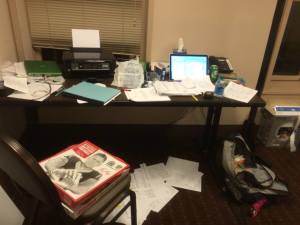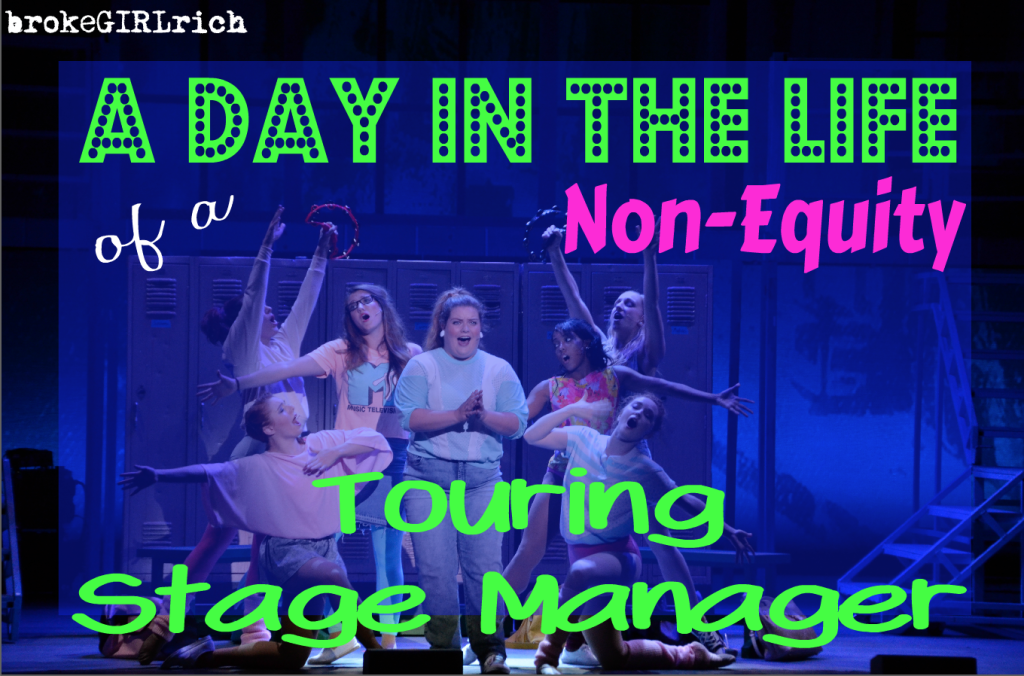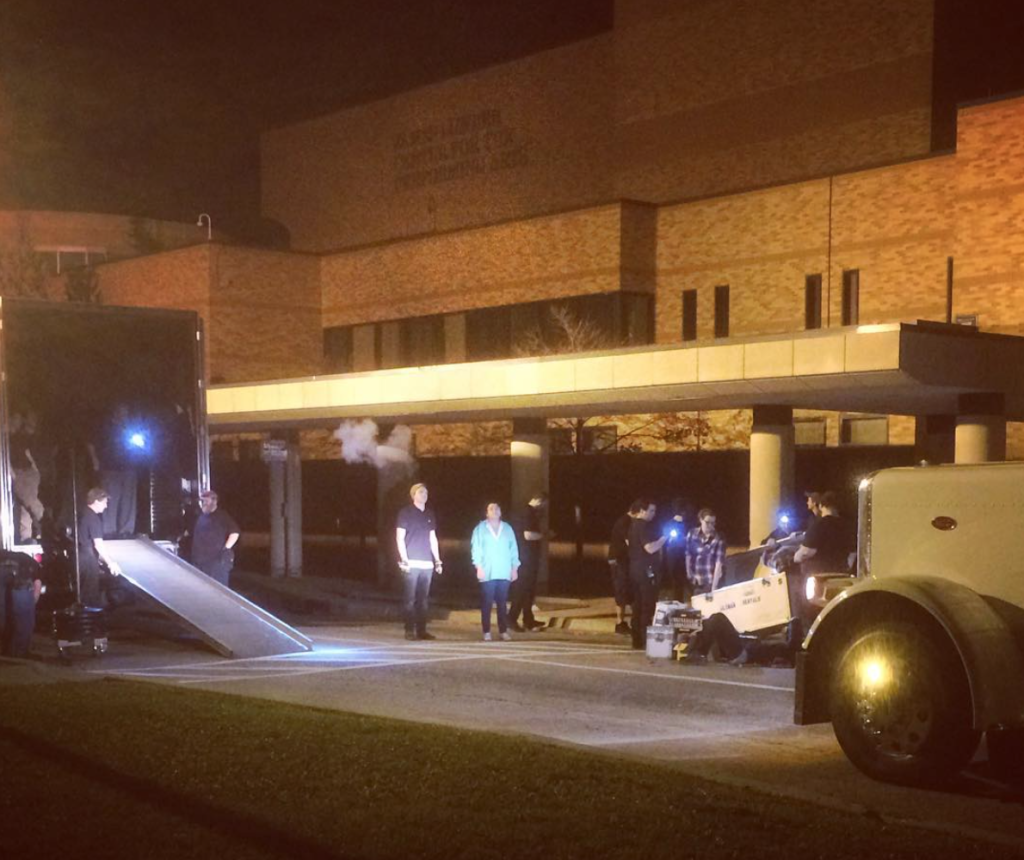It’s been a while since we’ve done a day in the life of! It occurred to me though that my days on my last tour were wildly different from any other job I’ve done.
I was on a bus and truck non-Equity national tour. The means that I lived on a sleeper bus. The fact that the tour was non-Equity meant that things like days off didn’t have to be taken into account and there were no limits on the number of hours a day you could work (and no overtime when the days were crazy long).
There were four kinds of days on this tour:
- One-Offs: This was 97% of our tour. A one-off is when you load in, do the show, and then load out all in one day.
- Sit-Downs: Sit-downs are when you stay multiple days in one city. These are much easier. We had about six of them in 5 months on the road, almost all of them were during the final month of the tour.
- Travel Days: If the drive is really long between two cities, the bus driver is required to take a break. That means that we would make part of our drive overnight, like usual, but wake up at a hotel instead of at a theater. We would have the day off in that city while the bus driver slept and we’d have a bus call in the late evening to get on the bus, sleep, and wake up at the theater the next day. They are pretty much a day off, but they’re not quite as restful as a proper day of not moving and getting to stay in a hotel like a golden day.
- Golden Days: Full days off. We had 2 Golden Days in our original schedule and during the run two venues cancelled on us and we got 2 extra days off and we still hit the minimum number of shows those weeks for a full week’s pay, so that was pretty awesome.
At the beginning of the tour, everything took a little longer. At the end of the tour, we had a pile of sit-downs. So here’s a look at an average day in the middle of the tour, when all the crew had their load in/load out groove mostly down and there were no crazy reblocking emergencies we were dealing with.
7:30 AM – Alarm goes off. I’ve probably already been half awake for 15 minutes anyway because you hear everyone’s alarm when you all sleep 3 feet away from each other.
7:32 AM – Grab my clothes from the junk bunk that is right across from me. Get dressed by doing the clothes changing shimmy in my bunk.
7:37 AM – Jump out of bunk and try not to land on anyone in bunk alley. It is extremely crowded at this time. Find my deodorant.
7:39 AM – Push my way to the back lounge. Use the mirror there to brush my hair.
7:42 AM – Push my way through to the bus bathroom, grabbing my backpack from my junk bunk on the way. Grab my shoes out of the bus bathroom shower. Put them on.
7:45 AM – Walk into the theater (7:45 AM was crew call for all evening load ins).
Note: If this day happened to be a matinee, everything would be pushed up two hours and our load in would begin at 6 AM.
7:45 AM – If in a non-union house, prowl around the stage for a few minutes. If in a union house, go nowhere near the stage until 8 AM. Look for dressing rooms. Find a bathroom so I can pee and brush my teeth.
8 AM – Load in starts. Our Technical Director would usually introduce all of us and then they’d crack the truck. My ASM would stay on deck and call out where everything coming off the truck needed to go.
8:10 AMish – When the SM road case came off the truck (it was one of the first off each day), I’d grab the dressing room signs and go set the dressing rooms. This could really vary in how long it takes. Some theaters had two large dressing rooms – one for boys, one for girls – so setting dressing rooms would take me about 15 minutes. Some theaters had 5,42562 tiny rooms – so setting dressing rooms could take 2 hours. Setting dressing rooms gets easier as a tour goes on because your cast will either start to tell you their preferences or you’ll hear their grumblings. You get to try to balance all of their personalities and keep people who hate each other as far apart as possible. You take into account distances for quick changes. There are a thousand surprising nuances to setting dressing rooms. Let’s say it was a normal sized theater today with a dozen useful dressing room spaces. This would probably take me about 45 minutes to an hour. Pop into wardrobe and give her a quick breakdown of where I put everyone, if it wasn’t blatantly obvious along a single hallway.
9:10 AMish – We’ll call it an hour since I usually get radioed to come look at something either onstage or in wardrobe. Now I’d swing by the stage and get the printer and office supplies for the Production Office and go set it up.
9:30 AM – We’ll assume the printer didn’t decide it hated me today, because that was a kind of regular thing and would turn into a lengthy battle some mornings. I’d print out any extra directional signs that are needed for the venue. I had plenty in with my dressing room signs (essentially arrows pointing Stage Left, Stage Right, to the Green Room, etc.), but some venues are crazy mazes. I’d print out any info for the callboard and go set it up in the Green Room. Check email.
10:00 AM – By now, my ASM has probably turned up in the Production Office and started any paperwork projects she was working on. I’d go pop my head onstage to make sure everything looks like it normally does. By this time I can usually get a feel for if we’re having an average day, an awesome day and the crew looks like they are ahead or a rough day and it looks like they’re behind. I can also check out the space a little better with the main frame of the set up and make sure there aren’t any obstructed spaces (which is a joke – it was more like I could figure out where the obstructed spaces were in the venues they kept sending us to).
10:10 AM – Check in with wardrobe. Make sure she has everything she needs.
10:20 AM – Double check the ASM has set out our cast board and show info board in the lobby. I usually just ask her in the office, but if I happen to be near there, I’ll just circle out and check it myself.
10:30 AM – Coffee break. Pretty much the reason I gained 15 pounds during this tour because I have no self control around donuts and there were always donuts. I’d also use this time to check in with our crew. The Technical Director would usually give me a call if anything was really different in this venue, but while we ate breakfast, our Props girl would usually mention if she thought there were going to be traffic issues in the wings with her props tables. Audio would mention if they were on track or behind. I would make it a point to check in with Lighting because my ASM and I called the focus, so I liked to know if they thought we’d be on schedule.
10:45 AM – Back to the Production Office to work on any paperwork that needs to be done. There was less and less of this as the tour went on and by the end, I could usually do 95% of the week’s paperwork during this time on the first day of the week and have the next hour or so pretty much free. This was also the time all tour when I could squeeze in taking a shower. Thanks to living on a bus, we had to shower in the venues. Right after coffee break until around 12:00 PM was pretty much my only guaranteed “down time” of the day other than meal breaks. I often had some free time in the afternoon, but if anything went wrong, that time wasn’t guaranteed.
12:00 PM – Lights would radio that they were about ready to start focus in a few minutes. This was usually the time we could tape down the number line and adjust any spike marks. We had two sets of spike marks on our set – one for our regular show and one for a smaller proscenium opening. My ASM and I would shift over spikes to make sure the right set were covered and uncovered.
12:10 PM – Lighting focus would start. I called overhead lights and my ASM called front of house. With a good crew, and a Genie that could move while it was up in the air, we could focus overhead in under 20 minutes. I would bounce focus the 4th electric after that, which on a good day I could do in about 15 minutes.
12:45 PM – I would be a stage potato for focus points and specials. While standing in the different special spots to set focus points, I would email our Dance Captain information about the stage, it’s width, any adaptations we have to make to the show and any unique issues related to the venue. In a few venues, the show required so many adaptations that I would do this process earlier, the Dance Captain and I would develop a plan and agree on what would need to be rehearsed when the cast arrived and I would send a detailed list of changes and problems to the entire cast. If it was something simple like we were just switching to Version B of the show because the proscenium opening wasn’t big enough, he’d tell them all on the bus, I’d put it on the callboard and that would be the end of it.

This is what our Production Office looked like on days when the Dance Captain got a REALLY long email.
1:00 PM – Lunch. If we had a rockstar crew and no technical issues, we might be done with load in now and have the afternoon off until the cast got in. Most of the time though, we still had a few lights to focus after lunch and all of the focus points and specials to set. Occasionally, if the crew was particularly unskilled, they might still be building the set and nothing regarding lights has started yet.
2:00 PM – Either finish up load in or nap or explore.
5:15 PM – Return to the building.
5:30 PM – Cast and band arrive. Go find the House Manager to go over holding seating, intermission length and how we’re going to communicate to start each act. Also request a house count for the end of the day.
6:00 PM – Band sound check.
6:15 PM – Cast sound check.
6:40 PM – Sometimes we would have local walk-ons as part of a PR contest. The Dance Captain and I would teach them their really simple role now.
6:50 PM – Locals mop and sweep stage.
7:00 PM – House opens.
7:30 PM – Showtime
9:55 PM – Show comes down. There might be a Meet & Greet type PR. Gather the assigned cast and take them to it.
10:15 PM – Meet & Greet ends. Cast and band bus leaves the building.
10:20 PM – Post show paperwork. Write up show report. Send out the next day’s schedule. Pack up Production Office. Change out of show blacks. Pack them up in the SM road box. Generally try to eat dinner while doing all this.
10:50 PM – Collect all microphones and microphone packs from the dressing rooms. Coil all the mic cables. Put in the correct road case.
11:20 PM – Go onstage. Help electrics if they’re not packed up already. Line up the electrics section of the truck pack if they are.
11:45 PMish – Call the electrics/road case pack of the last truck.
12:15 AM – If it was a smooth load out, we’d finish around now. Go pee one last time in a toilet that isn’t on a bus.
12:25 AM – Head out to bus. If I didn’t manage to eat dinner while writing the show report, eat it now. Possibly have a drink.
1:00 AM/1:30 AM – Go to sleep.
This tour had the roughest schedule I’ve ever worked. There were some weeks on cruise ships that were nearly as bad, but then the craziness (usually a cast changeover or a partial charter) would end and life would go back to normal there.
We also had a lot of really rough venues and a lot of places with really unskilled crews. And I’m not knocking crews in generally, we had some dynamite ones, but we were also sent to places like a community college in middle of nowhere Arkansas where our “crew” was a theater crafts class that showed up in flip flops and their teacher dropped them off for us to teach them and then disappeared.
There was also this delightful day when one of the wheels sheared off a roadcase and then the power went out during the load out. It had been a two show day, starting with a matinee. This load out finished after 2:30 AM.
Or this picture of all the happy people on the bus. Drinking mimosas for breakfast. Because we were broken down in a field in Iowa and we had to start our load in via phone with the locals. We got there about 3 hours late. Our busses broke down a lot.
While this schedule was pretty rough and some of the venues were literally the worst, this crew was hands down the best I have ever worked with. That’s not to say I didn’t work with some great crews before, but the level of madness they threw at us on this tour – I’ve never seen a group so cohesively rise to every challenge set to them like this one. I hope I get to work with all of them again someday.
Interested in what some of those other “day in a life’s” looked like? You can check them out here:









When I was in college, I was in the group that scheduled and coordinated the on campus entertainment. Most of the time it was pretty light fare, comedians or acoustic type stuff. But once per year they did a ‘big show’ where they brought in a national act. It was the longest day of the year, working to get everything setup, to all the work needed during the concert and then the tear down. It was so hard doing it one day a year (though I wouldn’t change it for the world as we had some great memories), and I couldn’t imagine doing it day in and day out. I have mad respect for those who do.
Money Beagle recently posted…6 Things That Troubled Brick And Mortar Stores Need To Do
You just go numb and keep moving. :oP And cross your fingers that you have a group of coworkers who are also incredibly skills and have a good sense of humor towards life.
Thanks for the insight into the touring world. I cant imagine what it feels like to be away from my bed for more than 11 days, but I guess you can still bring your pillow along the ride. Good luck on your next tour.
EL @ Moneywatch101 recently posted…How to Stop Financial Pride
Bus beds are surprisingly comfy actually. I kind of liked my little coffin – when we had good drivers.
Wow, that’s enough to make my head spin. Next time I see a show, I’m going to think long and hard about all the behind-the-scenes effort that goes into it. Thanks for a peek into your world.
Gary @ Super Saving Tips recently posted…Best Personal Finance Books to Read This Year
Thanks! But I think we’re doing our job best when no one in the audience is thinking about what’s happening behind the scenes ;o)
I had no idea that all this went on behind the scenes. I’m amazed at the energy that they still have when they are on stage!
Vickie@Vickie’s Kitchen and Garden recently posted…This Week in Our Home: Grandchildren, Painting, and Anniversary,
That’s amazing all the prep work and time that goes on before the show even begins!
Ann recently posted…Saving Money and Being Frugal – Week in Review – March 25, 2017
These are so interesting to me! I didn’t know you had to prep everyone’s dressing rooms. The whole tour sounds like madness, but I’m glad you had some great people with you along the way!
Femme recently posted…Financially Savvy Saturdays: 187th Edition
I love day in the life posts. I felt exhausted just reading it and to think on top of it all you manage to blog too.
Liz recently posted…FAFQs Series – Will My Student Loans Really Be Forgiven?
Hahaha. I usually think I’ve lost my mind when I sit down to work on my blog while I’m on tour. The schedule definitely gets a little hectic.
This is fascinating! The most I’ve ever done was a couple of years of stage crew back in high school. That was a pretty intense schedule you had. (I can never resist donuts, either! Yum!)
Jamie @ Medium Sized Family recently posted…5 Ways We’ve Saved Money This Week 69